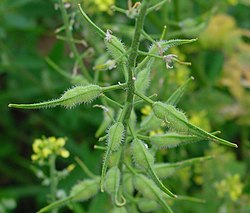White mustard
White mustard is an annual plant.
| White mustard | |
|---|---|

| |
| Scientific classification | |
| Kingdom: | |
| (unranked): | |
| (unranked): | |
| (unranked): | |
| Order: | |
| Family: | |
| Genus: | |
| Species: | S. alba
|
| Binomial name | |
| Sinapis alba | |
Uses
Cooking
The yellow flowers of the plant make seed pods, with each pod having a half dozen seeds. These seeds are harvested just before the pods become ripe.
White mustard seeds are hard and round, usually around 1 to 1.5 millimetres,[1] with a color forming from beige or yellow to light brown.
In Greece, the plant's leaves can be eaten during the winter, before it blooms. Greeks call it vrouves or lapsana.
The blooming season of this plant (February–March) is celebrated in the Mustard Festival.[2]
White Mustard Media
White mustard seeds (right) compared with rice seeds (left)
References
- ↑ David T. Balke and Levente L. Diosady; "Rapid aqueous extraction of mucilage from whole white mustard seed"; Food Research International; June 2000; 33 (5): pp. 347-356.
- ↑ http://mustardfestival.org





